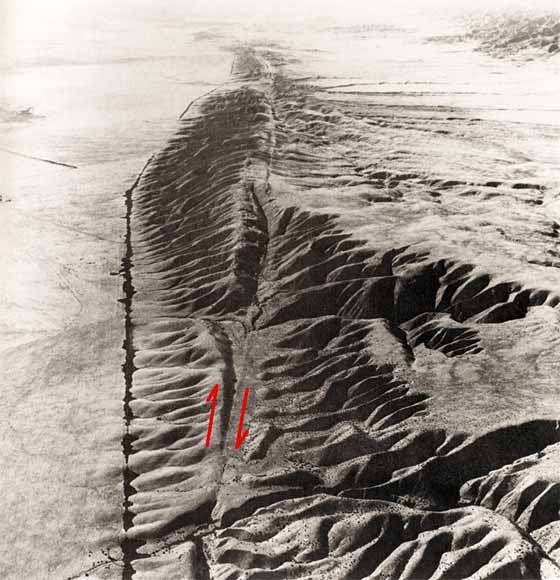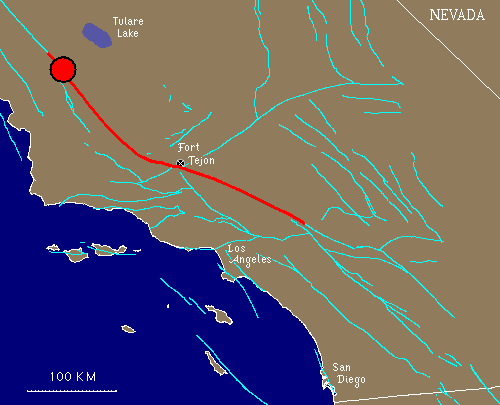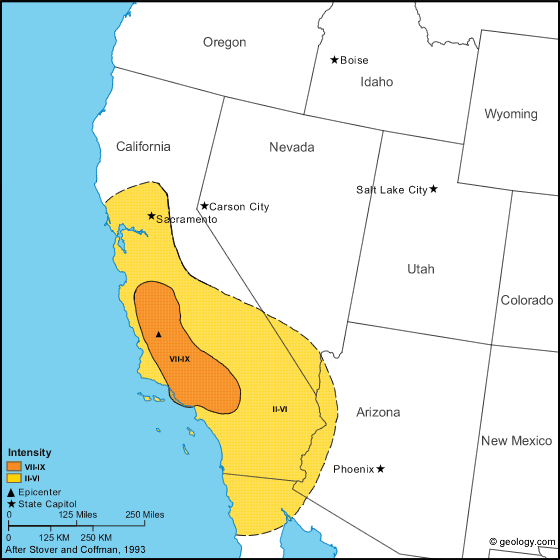|
|
The San Andreas Fault and the
Tejon Earthquake of 1857
 The 7.9 magnitude Tejon Earthquake (with an intensity of perhaps 8.25), which struck about 8:20 am on the morning of Jan. 9, 1857 is considered by many to be the largest historic earthquake that California has witnessed, vying for that title with the better known San Francisco quake of 1906. Both events resulted from right-lateral movement on the San Andreas Fault, and caused extensive damage over a wide area. The 7.9 magnitude Tejon Earthquake (with an intensity of perhaps 8.25), which struck about 8:20 am on the morning of Jan. 9, 1857 is considered by many to be the largest historic earthquake that California has witnessed, vying for that title with the better known San Francisco quake of 1906. Both events resulted from right-lateral movement on the San Andreas Fault, and caused extensive damage over a wide area.
Because few people lived in the San Joaquin Valley and surrounding mountains in those days, the Tejon quake was remote and this limited its impact. In fact, only two people were killed -- a woman at Reed's Ranch near Fort Tejon when an adobe house collapsed on her, and an elderly man in Los Angeles who fell dead from an apparent heart attack. Nonetheless, the quake left a surface rupture of 225 miles, which is shown below, with up to 30 feet of vertical displacement. This and other changes to the landscape were more extensive and impressive than those associated with the 1906 San Francisco earthquake, leading most seismolgists to consider the Tejon quake to be the larger of the two.

The epicenter of the Tejon quake is not known with certainty, but some suggest is was at Fort Tejon, near the middle of the surface rupture where the reported shaking was strongest. However, evidence indicates that foreshocks to the quake may have occurred at Parkfield (shown by the red circle in the map above), which would place the epicenter in that area.
 When the quake struck, the Kern River flowed upstream, and water ran four feet deep over its banks. Water from the Mokelumne and Los Angeles Rivers ran over their banks as well, leaving dry river beds in places, and supposedly the water of Tulare Lake was thrown shoreward, leaving fish stranded miles from shore on a dry lakebed. Some artesian wells in the Santa Clara Valley quit flowing, whereas others increased their flow, and new springs bubbled up near Santa Barbara and San Fernando. Ridges called moletracks several yards wide and a yard or more high formed in several places. The Santa Cruz and Ventura missions were damaged, and other missions sustained cracks. However, it was at Fort Tejon where the reported shaking was greatest, with the collapse of some of the buildings. In fact, it is said that the shaking lasted one - possibly two minutes, and if a quake with such sustained shaking were to hit today, the damage would be tremendous. When the quake struck, the Kern River flowed upstream, and water ran four feet deep over its banks. Water from the Mokelumne and Los Angeles Rivers ran over their banks as well, leaving dry river beds in places, and supposedly the water of Tulare Lake was thrown shoreward, leaving fish stranded miles from shore on a dry lakebed. Some artesian wells in the Santa Clara Valley quit flowing, whereas others increased their flow, and new springs bubbled up near Santa Barbara and San Fernando. Ridges called moletracks several yards wide and a yard or more high formed in several places. The Santa Cruz and Ventura missions were damaged, and other missions sustained cracks. However, it was at Fort Tejon where the reported shaking was greatest, with the collapse of some of the buildings. In fact, it is said that the shaking lasted one - possibly two minutes, and if a quake with such sustained shaking were to hit today, the damage would be tremendous.
|

|